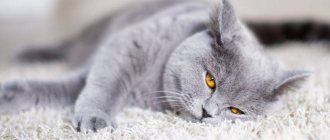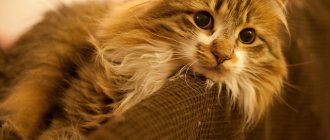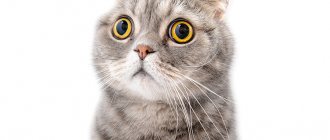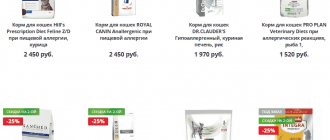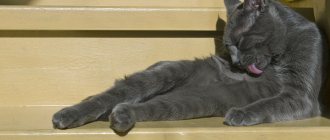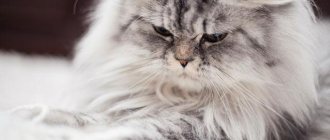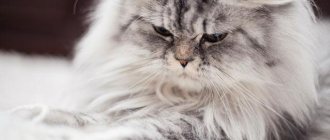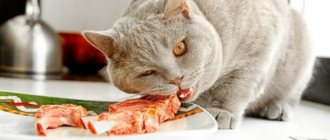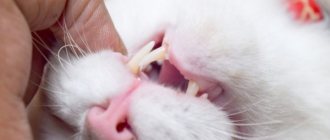Shedding in a cat is one of the most important problems that a person who does not know the characteristics of the cat’s body, character, cat breed, etc. may encounter.
You don't always need to sound the alarm when you notice that your cat has begun to shed heavily.
In this article we will consider such important issues as:
- What is the molting process?
- Why does a cat shed? (causes)
- Kittens' first molt
- Shedding periods in adult cats
- What to do if your cat sheds a lot? (medicines and grooming)
- Anti-shedding food
- What cat breeds don't shed?
- How we deal with our cat's shedding (advice from experienced people)
What is the molting process?
Shedding in cats
- This is a natural or forced process of hair loss, in which the animal’s body completely or partially loses its coat. Depending on the breed, age and reasons for shedding, this process can be either intense or subtle. Most cats shed in the spring and fall, but under certain conditions they shed throughout the year. In healthy animals, the end of shedding occurs when the old hair is completely replaced by a new, shorter or longer one.
Dangerous symptoms: severe shedding - possibility of disease
Molting, accompanied by a deterioration in the animal’s well-being, is a reason to consult a doctor.
Some representatives, for example, the British cat or other whiskers with a thick undercoat, shed their hair constantly, much more often than ordinary cats. But if a cat sheds heavily in summer and winter, becomes lethargic, does not play, has lost noticeable weight, sleeps for a long time and refuses to eat for a long time, this is a reason to sound the alarm. The factors behind such phenomena may turn out to be the most unpredictable; a history of some disease cannot be ruled out. Warning symptoms:
- Sudden loss of body weight. If a cat has suddenly lost weight for no apparent reason and the pet continues to experience active hair loss, disturbances in the gastrointestinal tract are possible.
- Hair loss in kittens. Summer or winter shedding does not apply to newborn babies. If a small pet does not stop losing hair and the owner has noticed it scratching parts of its body more than once, it means that there are parasites that urgently need to be gotten rid of.
- Motherhood. A cat sheds heavily during pregnancy and immediate motherhood, and during feeding. The reason is explained by a sharp change in hormonal levels. With this option, there is no need to panic, such shedding does not last long and after a complete restructuring of the body, the hair will stop falling out.
If there are incomprehensible symptoms, such as elevated body temperature, lethargy, lack of appetite, weight loss and excessive hair loss, you should not treat the cat yourself; it is better to show your beloved pet to a specialized veterinarian.
Why does a cat shed? (causes)
There may be several reasons for a cat to start shedding:
- seasonal shedding,
- sudden change in ambient temperature,
- diseases,
- stress,
- power replacement.
During seasonal molting,
when a cat’s coat becomes either lighter, or, “on the contrary,” thicker and warmer, there should be no reason for concern. This is a natural process, because our pets, anyway, are descendants of wild cats and are naturally supposed to react to warming or cooling. Unfortunately, any shedding is accompanied by the loss of a large amount of hair and, depending on what breed of cat you have, you will have to temporarily put up with some inconveniences associated with daily cleaning of the apartment or cleaning clothes from stuck cat hairs.
Sometimes, nature gives us “surprises” in the form of abnormally low or unusually high temperatures at a completely inappropriate time of year. For example, at the end of spring there may be a sharp cooling, or in the middle of autumn it may become very warm, down to summer levels. In such cases, the cat’s “internal clock” begins to go astray, and she rushes to acquire a coat of a suitable style. When the temperature anomaly ends, the animal sheds its “wrong” coat and the process of fouling with the appropriate coat begins again.
Health problems
, can also cause
molting
. It is important to know that some cat breeds (Maine Coons, British, Siberian) shed constantly and this is their normal condition. If your animal does not belong to the above breeds, but its fur literally comes out in clumps, then this may be a consequence of some disease. Most likely, these may be certain hormonal disorders or problems in the gastrointestinal system. This can be determined by the appearance of characteristic bald patches on the cat’s body, as well as by redness or itching on its skin.
Stress
– this is another factor that can lead to intense and untimely molting. Perhaps we often do not pay attention to the psychological state of our furry pets, but cats, nevertheless, are very impressionable and vulnerable creatures.
Often cats shed as a result of severe fright or prolonged nervous tension.
Even a change in the interior decor of the apartment can cause shedding, since cats are quite conservative in this matter. If an animal is very strongly attached to its owner, and he is absent for a long time, then the cat experiences great stress and may, as a protest, “decide” to have an unplanned molt.
Changing cat food
greatly affects the functioning of the animal’s gastrointestinal tract, can cause allergic reactions and, as a result, causes intense molting. If your “ward” suddenly starts to grow fur, then this is a sure sign that his body is rejecting the new menu. Immediately stop feeding your cat the new food and return to the food the cat was eating before. Menu variety is not always good. Cats don't have the same need for a variety of foods as people do. In nature, they generally try to adhere to a specific diet and give preference only to those products that they “trust.”
How to solve the problem of hair loss?
If the hair change has become pathologically stable, you need to examine your pet for viral, fungal and parasitic diseases. With a favorable medical verdict, you can fight shedding in cats at home.
Combing
A furminator will help simplify your regular hygiene procedure and increase its effectiveness. Using this comb in the form of a mini-rake, you can easily remove from the purr’s body not only dead undercoat hairs, but also tangles - breeding grounds for the larvae of flies and fleas. Working on the principle of a trimmer, the tool will allow you to massage the skin and provide a rush of blood to its deep layers, which will improve the nutrition of the hair follicles.
To alleviate the plight of a long-haired pet in the hot summer, some owners cut it with a clipper. Veterinarians do not approve of such drastic measures. A sheared animal becomes more vulnerable to adverse weather factors (wind, ultraviolet radiation), and may catch a cold in a draft or when the air conditioner is running.
An alternative to daily combing at home is a salon method of grooming - express shedding for cats. This procedure is carried out in two stages:
- applying a special mask to washed wool;
- combing and drying the fur coat after removing the mask.
With seasonal express shedding, owners will make life much easier for their pet and rid the apartment of the ubiquitous clumps of cat fur.
Bathing
Water treatments with the use of medicinal and cosmetic products for cats' shedding will not allow their thick fur coat to thin out. The action of caring shampoos, conditioners, and gels is aimed at eliminating the acid-base imbalance of the skin, improving the condition and growth of hair.
It is enough to bathe your meowing companion once every 2 months. After eating, at least 4 hours should pass before the water session. The water temperature must be adjusted within 35-38°C.
Sun-air baths
Daily exercise in the fresh air is the best way to strengthen the body's immune system. By introducing your pet to an active lifestyle, giving a lot of new experiences, regular walks will help prevent obesity, depression and reduce the timing of the off-season coat change.
Avoiding stress
Cats do not like change of environment and long absence of their owners. In order not to cause unnecessary anxiety to the fluffy, you should take this into account when changing apartments or traveling together, or when a new family member or pet appears in the house.
A comfortable means of transportation (container or bag) will help prevent stress. You can also resort to a sedative. Only purchase a pharmaceutical drug on the recommendation of a veterinarian. It is important not to forget that most of all the animal needs the moral support of its owners.
Improving the home microclimate
It is very important to maintain normal air temperature and humidity in the room where your pet is located. The house should be light and warm, but not hot - 22-24°C. Then the pet will not climb onto the radiators to bask. The rooms need to be regularly ventilated so as not to breathe dusty, dry air.
If the dimensions of the living space allow, you can allocate a separate room for the purr. The more spacious it is, the better. First you need to remove all “dust collectors” from it: curtains, carpets, upholstered furniture. The interior should be completed with a cozy cat house and a scratching post.
Deworming and vaccination
Regular medical examinations at the veterinary clinic, anthelmintic measures and timely immunization will allow the animal’s body to provide adequate resistance to viruses and parasites. Friendship with a veterinarian and following his advice are guaranteed to save your furry pet’s fur coat from demodicosis, ringworm and other skin scourges.
Proper feeding
Diet plays a huge role. Giving preference to ready-made factory feeds, you should avoid products belonging to the mass market class. They do not contain biotin, taurine and other cat shedding vitamins.
Cheap food contains many harmful elements: dyes, preservatives, flavoring additives. Health and shine to the hair will be ensured by high-quality food containing vitamin complexes, zinc, and omega-3 fatty acids.
The basis of natural nutrition should be animal proteins. Their main sources are:
- lean beef;
- chicken;
- low-fat fish (salmon, cod, halibut);
- seafood.
It is necessary to ensure the presence of boiled and raw vegetables in the food of your four-legged ward - a storehouse of vitamins and minerals:
- cauliflower;
- pumpkins;
- carrots;
- zucchini;
- turnips;
- greenery
Low-fat fermented milk products - kefir, cottage cheese - will have a beneficial effect on the condition of the skin.
Kittens' first molt
Kittens have their first moult
is accompanied by the replacement of undyed hairs with the hair of adult animals and
occurs
, most often,
at the age of 5-7 months, in spring or autumn
. When purchasing kittens, you should understand that their color will likely change. Shedding starts from the head and gradually continues throughout the kitten's body. The animal's head will receive its permanent color before other parts of the body, and the rest of the body can molt for a whole year or even more.
When do kittens change fur and eye color?
In the first year of life, a kitten not only adapts to its environment, grows, learns, plays, but also changes the color of its eyes and fur. Just as baby teeth fall out and give way to permanent teeth, the original color and color of the eyes change over time to adult ones. We will tell you at what age it is possible to determine the color of kittens and the color of their eyes, and when the kitten’s owners should expect the beginning of such changes in the pet’s appearance.
Changing eye color
For a newborn kitten, vision does not play a significant role. Babies open their eyes between one week and 16 days. Only in the third week of life do they begin to see. Until four weeks of age, a kitten's eyes are covered with a protective film; it disappears on its own when the time comes. Small kittens usually have blue or blue-gray eyes. This is due to the fact that almost all the pigments went to forming the fur color; they have not yet really reached the eyes. In one month, when the kittens' eye color changes, it becomes noticeable that splashes of a different color have appeared in the sky-blue iris.
The less pigment, the lighter and cooler the eye shade. At the time of birth, there is still very little pigment in the iris. For this reason, all babies have cool blue or light blue eyes.
The process of changing the color of a kitten's eyes is called pre-blooming. If you want a pet with a certain eye color, choose a baby around four months old. By this point, the kitten’s eye color has changed so much that one can conclude what it will be like throughout its life. With a 50% chance you can guess what your pet's eyes will be like by looking at the eye color of its parents. Some changes in eye color are possible before the age of two. Green eye color takes longer to form than others.
What to do if your cat sheds a lot? (medicines and grooming)
To reduce the negative effect of cat shedding, it can be “optimized.” Thus, there are a number of special medications that not only stop the process of heavy shedding, but also stimulate the formation of healthy hair in cats.
Neo
Omega
has proven itself well that promote the growth of healthy hair, containing Omega-3 substances and antioxidants.
In addition, there is a drug
Shed- Pro
, which stops intense shedding and removes the fur that has gotten there from the cat’s stomach.
Omegaderm
eliminates skin itching, restores the animal's skin and maintains the coat in proper condition.
Alloderm
Spot On
are drops for external use that quickly restore damaged epidermis and also significantly speed up the process of shedding.
Grooming (haircut)
Cat grooming is one of the effective ways to alleviate the possible consequences of shedding. Firstly, you will not need to constantly comb your cat and remove clumps of its fallen fur, and, secondly, you will prevent the cat from swallowing its own hair when licking, and thereby reduce the risk of obstruction of its intestinal tract.
Ways to reduce shedding
It is impossible to get rid of natural shedding. Only serious illnesses require drastic interventions. And in normal times, we can only slightly reduce hair loss.
Vitamin complexes
Supplements reduce the amount of hair loss. Be sure to consult with your veterinarian about which vitamins are right for your pet.
Vitamins help against hair loss
Along with the supplements, you can give yolk (if you are not allergic) and sprouted grass.
Sprouted grass is useful in combination with vitamins
Buy a special paste for removing hairballs from the body of cats.
Special feed
A balanced diet is very important during such a period.
To ensure that the fur is always beautiful and healthy, and molting is not a severe torment, the animal’s food must contain: biotin (vitamin B7, deficiency leads to inflammation in the hair follicles. Acute biotin deficiency can lead to baldness) taurine, sulfur (enhances the effect of biotin ), vitamins B6, B2, B5, iodine, calcium, phosphorus, omega-3, omega-6.
Cat food is rich in essential nutrients
If the cat's diet consists of regular foods, then biotin and vitamin B6 must be present, which are found in beef, pork, chicken yolk, salmon, poultry, cheese, carrots, and buckwheat. But keep in mind that cats may be allergic to “human” food.
Dry food must be of high quality, at least super premium. They have everything you need to feed your pet.
There are two types of food recommended for consumption during shedding:
- Food for healthy skin and coat.
- Food for removing hair from the stomach.
Bathing and brushing
During washing and combing immediately after bathing, a very large amount of dead hair is removed.
More fur is combed after bathing
For cats with short fur, it is enough to brush them a couple of times a week with a regular comb. For fluffy, long-haired breeds, you will most likely have to take a Furminator. This is a professional device with very fine teeth.
Cats with long and thick hair are best combed with a furminator.
SEE THE STAGES OF KITTEN DEVELOPMENT IN THE KITTEN GROWTH TABLE
Let's consider all stages of development of kittens from birth to one year, their characteristics of maturation and growth, features of care at each age.
A newborn kitten is born weighing 80-120 grams, the size of kittens at birth is body length about 9-12 cm.
Very rarely, but still there are cases of the birth of kittens 50-70g, they are small but active. This does not always serve as a signal that the kitten is sick or has abnormalities. This also occurs in multiple pregnancies or in the case of small parents.
Newborn kittens: photo of the litter Newborn kittens are absolutely helpless during this period, they are blind, deaf, and do not know how to regulate their temperature. Newborn kittens have no undercoat; the fur is thin, weak and does not warm at all.
Newborn British kittens Kittens do not know how to stand on their paws, their bones are very fragile, so babies require special care. At this time, sleep and kittens are almost inseparable concepts. Newborn kittens sleep almost constantly and eat a lot and often. Kittens need sleep for the further development of their nervous system. Newborn kittens also cannot defecate on their own; the mother cat licks their genitals and eats their feces. What is really well developed in newborn kittens is their sense of smell and touch; they easily find their mother’s nipples, fingering them with their paws, sucking and, thereby, stimulating further milk production.
Newborn kittens: photo of the litter During this period, it is better not to touch the kittens at all, just monitor their weight. Kittens should add it daily (about 10-20 grams per day), if the kitten is growing, then everything is in order.
Things to take care of:
- Set up a box for a cat (or organize a maternity house) with newborn kittens. It should be warm and dry there. The bedding should be changed (it is advisable to use white sheets to track the color of the mother cat’s discharge), because The cat will have postpartum discharge. Also, if necessary, you can put a heating pad.
- Cat food. It should be plentiful and balanced; food is a must for nursing cats. Food and water should be freely available, next to the nest box. It is also recommended to place a tray here.
Cats are by nature excellent mothers and may not leave the box for a whole week, so it is important that newborn kittens have enough milk. In the first days, the cat produces colostrum (very fatty, nutritious milk that has antibodies, thanks to which kittens develop lasting immunity).
If there are a lot of kittens, be sure to make sure that each newborn kitten gets its good portion.
The development of kittens after birth (the development of newborn kittens) is very active, so the first week can be planned out day by day.
Causes and signs of pathological molting
How can you tell if shedding is a symptom of a disease and not a seasonal natural process? Signs of pathological hair loss:
- cover change lasts longer than 2 months;
- in place of the fallen hair, bald spots remain that do not heal for a long time;
- redness, rash, ulcers appear on the skin;
- the animal’s behavior changes: it becomes nervous, irritable or, conversely, lethargic, and loses appetite.
What can cause the pathology:
- Hormonal disbalance. Endocrinological diseases, the inability to reproduce in non-castrated animals - all this can affect the condition of a pet’s coat.
- Stress. A change of environment, moving, severe fright - all this can cause hair loss. Some animals are calm about changes in external circumstances, while other cats become nervous even when a stranger comes into the apartment and tries to pet them.
- Poor nutrition. Nutrition has a significant impact on a cat's condition. The food must be balanced and contain the required amount of vitamins, macro- and microelements. If the owners give their pet food from their table or feed them cheap food, then its fur may become dull, lose its natural shine and begin to fall out.
- Allergy. One of the symptoms of allergic dermatitis is hair loss. The disease is also accompanied by itching, the cat scratches the sore spot, and non-healing wounds form on the skin. Allergies can be caused by household chemicals, medications, and food.
- Infection with parasites and fungus. The hair begins to fall out in patches, and large bald spots form. The skin itches, a rash appears, and festering ulcers appear. The animal should be taken to the veterinarian immediately, because such infections are dangerous for people and lead to serious consequences for the cat’s health.
